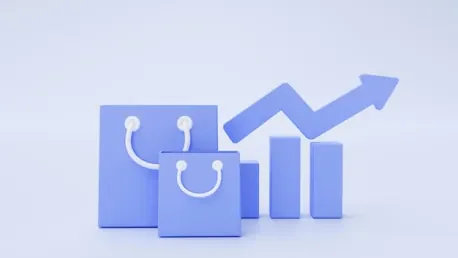The world of retail is ever-evolving, and keeping a finger on its pulse is crucial for understanding broader economic trends. Today, we have the pleasure of discussing the latest projections and trends in retail with Zainab Hussain, a seasoned e-commerce strategist. Her expertise in customer engagement and operations management provides valuable insight into the National Retail Federation’s (NRF) optimistic outlook for 2025.
Can you explain NRF’s projection for retail revenue growth in 2025?
The NRF is forecasting a retail revenue growth between 2.7% and 3.7% for 2025, bringing total retail sales to somewhere between $5.42 trillion and $5.48 trillion. This is seen as a positive sign, even amid some ongoing economic uncertainties.
What factors are contributing to this anticipated growth?
Economic momentum supported by low unemployment rates and real wage gains are key factors driving this growth. Despite some policy uncertainties that affect consumer and business confidence, retailers remain focused on serving their customers, which helps maintain stability in the retail sector.
How has the US economy shown momentum so far in 2025?
The economy has maintained a good pace, primarily due to low unemployment levels and real wage growth. These factors contribute to a stronger consumer base, which is essential for ongoing economic momentum.
What specific aspects of the economy are bolstering this momentum?
Key aspects include strong employment figures and wage growth. When people are employed and earning more, they tend to spend more, bolstering economic activity. This creates a positive feedback loop that supports overall momentum in the economy.
What are the significant policy uncertainties weighing on consumer and business confidence?
Uncertainties mainly revolve around fiscal and monetary policies, including concerns about inflation and tariffs. These factors can create a cautious outlook among consumers and businesses, affecting their spending and investment decisions.
How does NRF view the current status of consumer spending?
The NRF sees consumer spending as stable, supported by the strong fundamentals of low unemployment, income growth, and solid household finances. While growth may be slower, it’s not expected to unravel anytime soon.
Why do you believe consumer fundamentals remain intact despite slower growth?
Fundamentals like steady income growth and overall solid household financial health play significant roles. As long as people have jobs and their financial health remains robust, consumer spending is likely to continue at a stable rate, even if the growth rate slows.
What is the expected growth rate for non-store and online sales in 2025?
Non-store and online sales are projected to grow by 7% to 9%, which would bring them to between $1.57 trillion and $1.6 trillion. This is slightly less than the 8.1% growth observed the previous year but still a substantial increase.
How does this compare to the growth rate in the previous year?
The previous year saw an 8.1% increase in non-store and online sales, reaching $1.47 trillion. While this year’s growth rate is expected to be slightly lower, it still represents robust expansion in the online sector.
What is NRF’s revised expectation for GDP growth in 2025?
The NRF has revised its GDP growth expectations to just under 2% for 2025, which is lower than the 2.8% growth observed in 2024. This reflects a more cautious outlook for overall economic growth.
How does this compare to the GDP growth seen in 2024?
In 2024, GDP grew by 2.8%, so the revised expectation of just under 2% for 2025 signifies a notable decrease. This anticipated slowdown is due to various economic and policy uncertainties.
How is tariff-induced inflation affecting consumer spending?
Tariff-induced inflation is placing upward pressure on prices, which can strain consumer budgets. Despite this, the impact isn’t expected to lead to a drastic reduction in spending, but it does contribute to a slower growth trajectory for consumer spending.
What are NRF’s expectations for PCE inflation in 2025?
The NRF expects personal consumption expenditures (PCE) inflation to remain around 2.5% throughout 2025. This consistent rate indicates that while inflation is present, it isn’t escalating at an uncontrollable pace.
How would you describe the overall household financial health in 2025?
Overall, household financial health appears robust, with slight increases in delinquencies for auto loans and credit card payments remaining close to pre-pandemic levels. This suggests that households are managing their financial obligations fairly well.
Are there any concerns regarding delinquencies for auto loans and credit card payments?
While there have been slight increases in delinquencies, they’re still consistent with pre-pandemic trends. This means there’s no immediate cause for alarm, although it’s something to keep an eye on moving forward.
Why does NRF exclude automobile dealerships, gas stations, and restaurants in its forecasts?
NRF focuses on core retail segments, excluding categories like automobile dealerships, gas stations, and restaurants, to provide a clearer picture of traditional retail performance. These excluded sectors can be heavily influenced by other economic factors, which may not directly reflect consumer retail trends.
How does this exclusion help NRF concentrate on core retail segments?
By excluding these sectors, NRF can deliver more accurate insights into core retail activities. This helps in understanding the performance of retail segments that are more directly related to consumer shopping behavior.
What significant trends were observed in the retail sales figures for February and January 2025?
For February 2025, seasonally adjusted retail sales increased by 0.2% from January, while the unadjusted year-over-year figure rose by 3.1%. In January, there was a seasonally adjusted decrease of 0.9% from December, but an unadjusted year-over-year rise of 4.2%, highlighting some monthly variability.
How did these figures compare when adjusted seasonally and unadjusted year-over-year?
The seasonally adjusted figures show slight month-to-month variability, while the unadjusted year-over-year increases indicate stronger underlying growth trends, suggesting that consumer spending remains solid despite short-term fluctuations.
How did the annual retail sales growth for 2024 align with the decade’s pre-pandemic average?
The annual retail sales growth for 2024 was 3.6%, matching the pre-pandemic decade’s average growth rate. This alignment indicates a return to, and stabilization of, long-term growth trends in the retail sector.
What are your expectations for the retail sector’s performance in the coming years?
Looking forward, I expect the retail sector to continue experiencing steady growth, supported by strong consumer fundamentals and ongoing adaptation to e-commerce trends. However, macroeconomic factors such as inflation, tariffs, and policy changes will need to be closely monitored as they will influence the overall trajectory.
Do you have any advice for our readers?
Stay informed about economic trends and maintain flexibility in your financial planning. Understanding the broader economic context can help make more informed decisions, whether you’re managing a business or your household budget.









